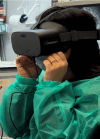The impact of virtual reality technology in the era of See & Treat hysteroscopy: a randomised controlled trial
- PMID: 40546021
- PMCID: PMC12233116
- DOI: 10.52054/FVVO.2025.48
The impact of virtual reality technology in the era of See & Treat hysteroscopy: a randomised controlled trial
Abstract
Background: In the context of outpatient hysteroscopy (OPH), performing a single procedure integrating the operative and diagnostic part is known as "See & Treat hysteroscopy". The virtual reality (VR) technology provides an immersive virtual environment that can provide a non-invasive analgesic. To date, there is limited evidence regarding its use in the OPH setting.
Objectives: To evaluate the feasibility and effectiveness of VR technology for pain and anxiety management in OPH.
Methods: Unblinded, prospective, randomised controlled trial, conducted at the Hysteroscopy Unit of the University of Naples "Federico II" between May and July 2024. Women aged 18-70 years, indicated for OPH, were randomised into a control group (standard OPH care) and an intervention group (OPH care with the addition of a VR headset).
Main outcome measures: Pain and anxiety were assessed through subjective measures: numerical rating scale (NRS) scores before and after the procedure, and objective measures: heart and respiratory rate pre- and during the procedure. Satisfaction, time, and success rates were also evaluated.
Results: Overall, 116 women were enrolled. The VR group compared to the control group reported significantly lower mean standard deviation NRS scores for pain [3.9 (2.7) vs. 5.4 (3.0); mean difference 1.5, 95% confidence interval (CI) 0.4 to 2.5] and anxiety [3.2 (2.1) vs. 4.8 (2.8); mean difference 1.6, 95% CI 0.7 to 2.5] respectively. Regarding satisfaction, 96.5% of the VR group would use the headset again, whereas 3.5% requested its removal. All women in the control group desired a distraction. No serious adverse events were reported.
Conclusions: VR technology proved feasible and effective for pain and anxiety management in OPH, particularly during operative procedures.
What is new?: Its use can support the implementation of the See & Treat philosophy.
Keywords: Outpatient hysteroscopy; pain and anxiety; virtual reality technology.
Conflict of interest statement
Figures
Similar articles
-
Effect of virtual reality on pain and stress in children during Kirschner-wire removal after fracture treatment: a randomized clinical trial.Br J Surg. 2025 May 31;112(6):znaf075. doi: 10.1093/bjs/znaf075. Br J Surg. 2025. PMID: 40526816 Clinical Trial.
-
Uterine distension media for outpatient hysteroscopy.Cochrane Database Syst Rev. 2021 Nov 26;11(11):CD006604. doi: 10.1002/14651858.CD006604.pub2. Cochrane Database Syst Rev. 2021. PMID: 34826139 Free PMC article.
-
Hypnosis for pain management during labour and childbirth.Cochrane Database Syst Rev. 2016 May 19;2016(5):CD009356. doi: 10.1002/14651858.CD009356.pub3. Cochrane Database Syst Rev. 2016. PMID: 27192949 Free PMC article.
-
Pramipexole in addition to mood stabilisers for treatment-resistant bipolar depression: the PAX-BD randomised double-blind placebo-controlled trial.Health Technol Assess. 2025 May;29(21):1-216. doi: 10.3310/HBFC1953. Health Technol Assess. 2025. PMID: 40455248 Free PMC article. Clinical Trial.
-
Pain management for tubal sterilization by hysteroscopy.Cochrane Database Syst Rev. 2012 Aug 15;2012(8):CD009251. doi: 10.1002/14651858.CD009251.pub2. Cochrane Database Syst Rev. 2012. PMID: 22895987 Free PMC article.
Cited by
-
Virtual reality for pain relief in gynaecological care.Facts Views Vis Obgyn. 2025 Jun 27;17(2):99-100. doi: 10.52054/FVVO.2025.178. Epub 2025 Jun 17. Facts Views Vis Obgyn. 2025. PMID: 40525897 Free PMC article. No abstract available.
References
LinkOut - more resources
Full Text Sources


